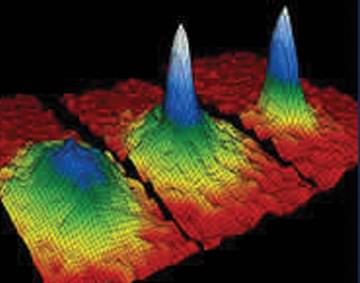The BEC phenomenon was first predicted by Satyendra Bose and Albert Einstein: when a given number of identical Bose particles approach each other sufficiently closely, and move sufficiently slowly, they will collectively convert to the lowest energy state: a BEC. This occurs when atoms are chilled to very low temperatures. The wavelike nature of atoms allows them to spread out and even overlap. If the density is high enough, and the temperature low enough (mere billionths of degrees above absolute zero), the atoms will behave like the photons in a laser: they will be in a coherent state and constitute a single “super atom.”
JILA’s Carl Wieman (University of Colorado, Boulder) and Eric Cornell (NIST) first started searching for a BEC around 1990 with a combination laser and magnetic cooling apparatus. Wieman pioneered the use of $200 diode lasers (the same type used in CD players) instead of the $150,000 lasers other groups were using. His approach was initially met with skepticism by his colleagues, but when he began to report real progress, several other groups joined the race to achieve the first BEC. Beginning with rubidium gas atoms at room temperature, the JILA team first slowed the rubidium and captured it in a trap created by laser light. This cooled the atoms to about 10 millionths of a degree above absolute zero—still far too hot to produce a BEC.
Once trapped, the lasers are turned off and the atoms are held in place by a magnetic field. The atoms are further cooled in the magnetic trap by selecting the hottest atoms and kicking them out of the trap. Then came the tricky part: trapping a sufficiently high density of atoms at temperatures that were cold enough to produce a BEC. To do this, Wieman and his colleagues had to devise a time-averaged orbiting potential trap (an improvement to the standard magnetic trap).
